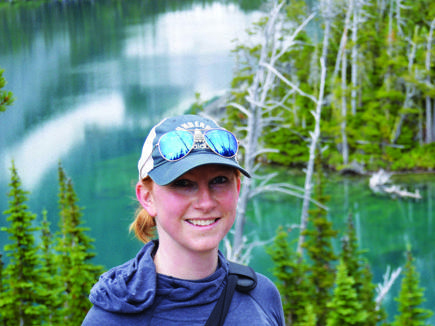Laina Mercer
Institute for Disease Modeling
Bellevue, Washington
Department: Polio group
Education: A.S. Geology, Skagit Valley College, 2004 B.S. Mathematics, Minor in Chemistry, 2008, Western Washington University; M.S. Biostatistics, 2011, University of Washington; Ph.D. Statistics with certificate in Demographic Methods, 2016, University of Washington
Career stage: Early—9 years post Bachelor’s

What She Does
One of the things Laina likes most about her job is the day-to-day variability: an average day could include discussing analyses with colleagues, meeting with collaborators, working on analyses, communicating results through presentations, or writing reports or scientific manuscripts. The most rewarding part of her job is when the results of an analysis lead to or help guide action. The recent work she is most proud of is the incorporation of their polio risk modeling work into the National Emergency Action Plan for Polio Eradication in Pakistan. The analysis helped tier districts in terms of risk and prioritize them for vaccination campaigns and special interventions.
Necessary Job Skills
Mathematics is the foundation of all the statistical and mathematical models that are used to estimate things about populations of interest and learn about disease dynamics, and computational science allows us to implement these models accurately and efficiently on a large scale. Solid math skills and computer skills are necessary to help develop models.
I was surprised by how important the ability to communicate mathematical concepts to people from different disciplines would be and how much I would enjoy doing so.
Pros and Cons of Her Job
Laina’s favorite thing about being a statistician is the variety of applications. In her current position, she uses statistical approaches to help answer challenging public health questions. It was important for her to find a position that wasn’t too isolated from other scientists or the impact of their work. The opportunity to travel has been a bonus.
Work/Life Balance
Laina’s job has quite a bit of flexibility in terms of what hours employees work and where they work them. The most important thing is that they do high quality work and meet their commitments.
Career Path
Laina’s plan was to pursue a Master’s degree in teaching and become a high school teacher, but her path changed entirely during the summer before her senior year of college, when she participated in a research experience for undergraduates (REU) funded by the National Science Foundation. She spent that summer working with three other undergraduates on estimating false discovery rates, a biostatistics method used when conducting multiple statistical comparisons simultaneously. This was her introduction to applied statistics and statistical research, and it turned out to be a great fit for her. After completing a Master’s degree in biostatistics, Laina worked for two years with a group providing biostatical consultation and collaboration at a children’s hospital. During this time, she met statisticians in a variety of professional roles with varying levels of education, which provided her with a sense of non-academic career options for statisticians with Ph.Ds. When she returned to school for her Ph.D. she focused on methods that would be applicable in public health settings, so she concentrated on survey sampling, spatial statistics, and demography. Now a big part of her job is using spatial models to predict the risk of polio cases for sub-national regions of Pakistan and Nigeria.
I have always been a “planner”, but I have found that it is important to be flexible and keep an open mind about unforeseen opportunities.
Laina heard about the NSF REU program by talking to upperclassman in the math department, learned about the field of biostatistics from her REU advisor, and found her current job by responding to a job announcement sent to her department. It may look like it all “fell into place,” but it certainly felt more like a random walk to Laina.
Career Expectations and Advice
“Find people who have the job you think you want and ask them questions about how they spend their days and what they like about their job.”
More importantly, try to get experience outside of the classroom. Internships and research opportunities will tell you a lot about what type of work you will enjoy.
Salary
The starting range for a statistician in a non-profit research or public health is $100,000–$120,000.
Stay Up-to-Date with Email Alerts
Sign up for our monthly newsletter and emails about other topics of your choosing.

